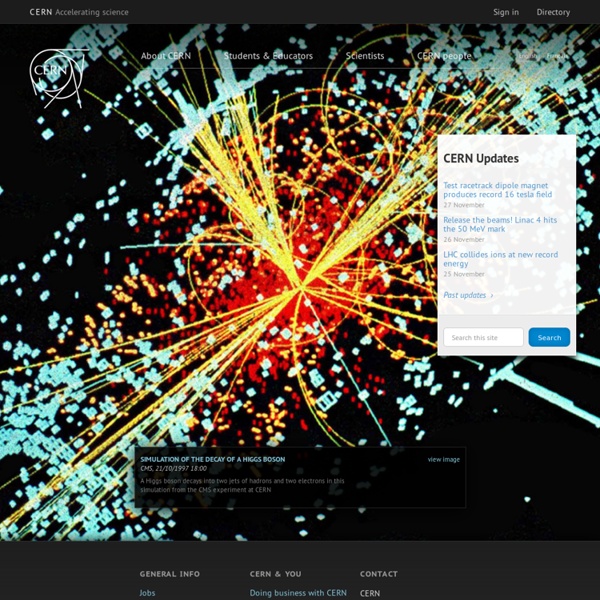



Quantum mechanics - Wikipedia Wavefunctions of the electron in a hydrogen atom at different energy levels. Quantum mechanics cannot predict the exact location of a particle in space, only the probability of finding it at different locations.[1] The brighter areas represent a higher probability of finding the electron. Quantum mechanics (QM; also known as quantum physics, quantum theory, the wave mechanical model, or matrix mechanics), including quantum field theory, is a fundamental theory in physics which describes nature at the smallest scales of atoms and subatomic particles.[2] Quantum mechanics gradually arose from theories to explain observations which could not be reconciled with classical physics, such as Max Planck's solution in 1900 to the black-body radiation problem, and from the correspondence between energy and frequency in Albert Einstein's 1905 paper which explained the photoelectric effect. History[edit]
Einstein for Everyone Einstein for Everyone Nullarbor Press 2007revisions 2008, 2010, 2011, 2012, 2013 Copyright 2007, 2008, 2010, 2011, 2012, 2013 John D. Norton Published by Nullarbor Press, 500 Fifth Avenue, Pittsburgh, Pennsylvania 15260 with offices in Liberty Ave., Pittsburgh, Pennsylvania, 15222 All Rights Reserved Further Study - Choosing your Career - Students - Careers Service Some useful resources For the vast majority of postgraduate courses and research programmes there is no centralised application system; you simply apply direct to the institution concerned. In most cases, there will be no fixed closing date, but you need to check this with the institution. Generally speaking, it is advisable to apply nine to twelve months before the intended starting date, especially as this may improve your chances of obtaining funding.
The Empire Didn’t Strike Back… The Demise of FuturICT Posted by gregfisher on Jan 22nd, 2013 in Blog , Social | 6 comments By Greg Fisher Last week the European Commission chose not to invest in FuturICT, which was a massively ambitious project to integrate ICT and complexity science. The Phenomenon Of Light Generation Through The Crushing Of Materials Is Called? Answer: Triboluminescence The word might sound rather scientific, and maybe a little alien in nature (“triboluminescence” does sound a whole lot like a problem the crew of the Enterprise might run into, after all), but it’s a down-to-Earth phenomenon you may have even experienced yourself. Triboluminescence is light created when crushing, tearing, or other mechanical action triggers the breakdown of chemical bonds in a material (or when peeling adhesive tapes). A popular classroom demonstration of this phenomenon, for example, is to give students rolls of Wint-O-Green Mint Lifesaver candies, enter a darkened room, and then have the students—much to their delight—throw tons of the candies into their mouths and chomp on them vigorously with their mouths open. Thanks to a double whammy of the shearing of the sugar structure of the candy and the crushing of the wintergreen oil (which fluoresces), both generate triboluminescence, and the students are treated to sparks of blue-white light.
The Large Hadron Collider The Large Hadron Collider (LHC) is the world’s largest and most powerful particle accelerator. It first started up on 10 September 2008, and remains the latest addition to CERN’s accelerator complex. The LHC consists of a 27-kilometre ring of superconducting magnets with a number of accelerating structures to boost the energy of the particles along the way. Inside the accelerator, two high-energy particle beams travel at close to the speed of light before they are made to collide. Home page of E-Futures Doctoral Training Centre for Interdisciplinary Energy Research E-Futures is a Doctoral Training Centre that will train a new generation of scientists and engineers to address the challenges inherent in making the transition to a sustainable energy future. Students will receive an overview of energy issues in the first year of their training before developing individual specialisations through research projects. E-Futures draws together world-class research within the University of Sheffield to train engineers and scientists with the skills, knowledge and confidence to tackle today's evolving issues regarding energy generation, management and supply. E-Futures also represents a new working culture, fostering relationships between teams in universities and forging lasting links with industry and other external organisations.
The book The Functional Art is an introduction to Information Graphics and Visualization, the communication of facts and data by means of charts, graphs, maps, and diagrams. It includes a DVD including 90 minutes of video lectures. Download three chapters for free here